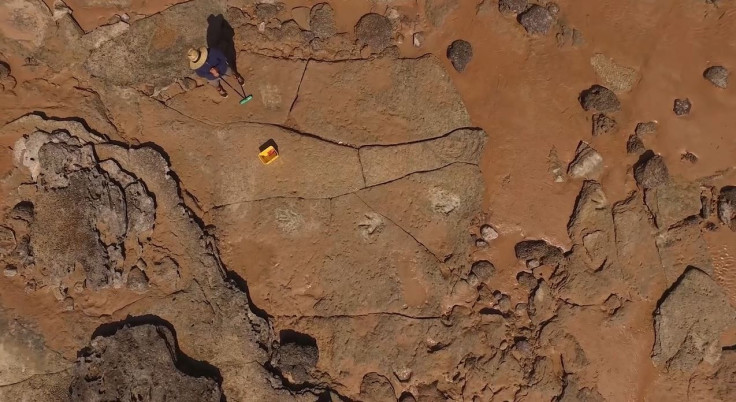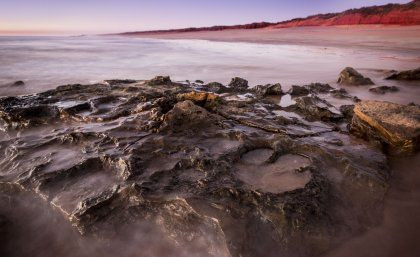Dinosaur Park: Thousands Of Dino Tracks Are Hiding Under Tides In Western Australia

Think of it as a more passive version of Jurassic Park — rather than live dinosaurs, one area in Australia has dinosaur tracks cast into ancient rock that can be connected to 21 different species.
The tracks are revealed during low tide, when the water recedes from the coast. A study in the Journal of Vertebrate Paleontology says researchers were able to identify the signatures of so many creatures that the foot impressions represent “almost the entire fossil record of dinosaurs from the western half of the Australian continent.”

Scientists have previously identified several dinosaur tracks in this area and suggested there could be more, but according to the authors their project is the first to do a detailed investigation and identify so many different dinos from their tracks there.
They were discovered along a 15-mile stretch on the coast of a knob of land in Western Australia called the Dampier Peninsula, on the Indian Ocean. There is a rock formation in that spot known as Broome Sandstone that dates back to between 127 million and 140 million years ago, according to a statement from the University of Queensland. Based on the tracks, which were formed during the Cretaceous period, the paleontologists can learn more detail about the dinosaurs that existed in the region at that prehistoric time.
Read: Two Extinct Reptiles Are Actually the Same Animal
Paleontologists took five years to study thousands of tracks, the study said, but so far have only been able to identify 150 of them. They say those tracks can be linked to at least 11 different dinosaur species, but they could represent as many as 21. All of those come from four main dino groups: theropods, which were the ancestors of modern birds; the enormous herbivores called sauropods; the two-legged ornithopods, which were also herbivores; and the armored dinos called thyreophorans.
“Among the tracks is the only confirmed evidence for stegosaurs in Australia,” lead author Steve Salisbury said in the statement from Queensland, which also worked with James Cook University on the project. A stegosaurus is one of the armored dinosaurs. “There are also some of the largest dinosaur tracks ever recorded. Some of the sauropod tracks are around [5.5 feet] long.”
They also have age on their side: Salisbury noted that the tracks are older than most of the fossils that have been previously found in Australia’s eastern half, which are in the neighborhood of 100 million years old.
“It’s such a magical place — Australia’s own Jurassic Park, in a spectacular wilderness setting,” Salisbury said.
See also:
DNA Links Aboriginals to Australia for 50,000 Years
Prehistoric Climate Change Caused 3 Mass Extinctions in a Row
© Copyright IBTimes 2024. All rights reserved.





















